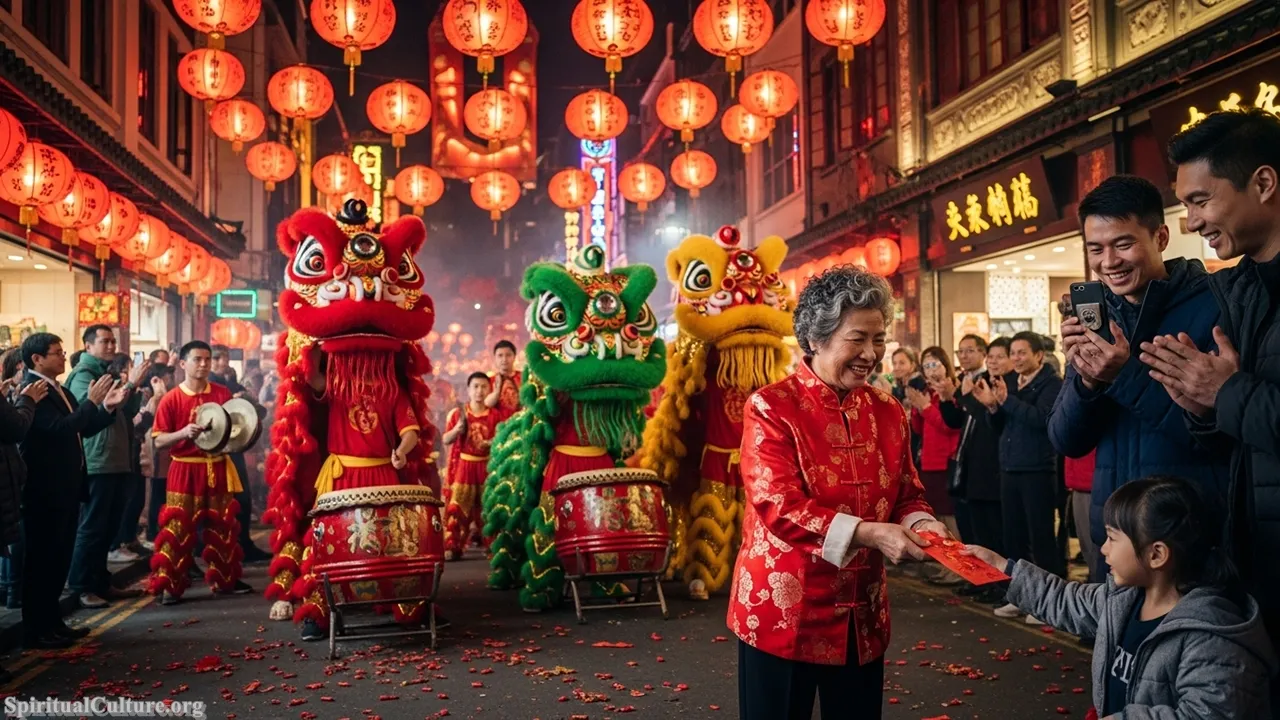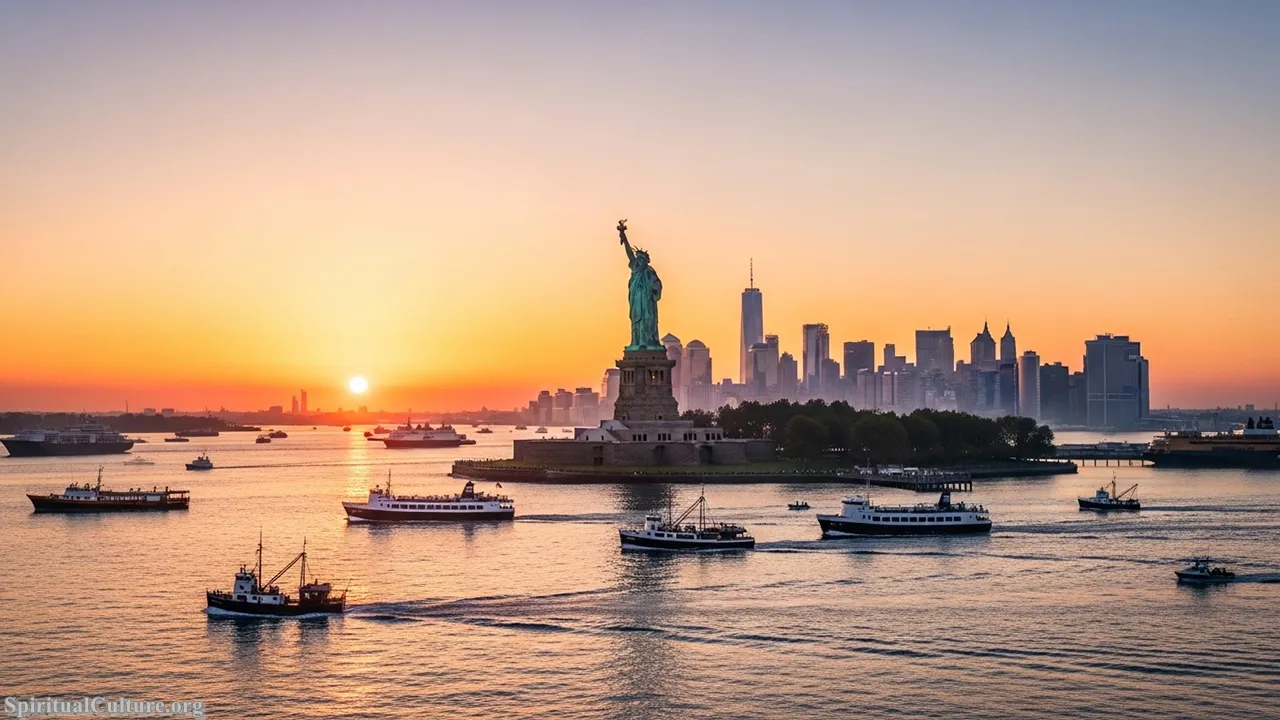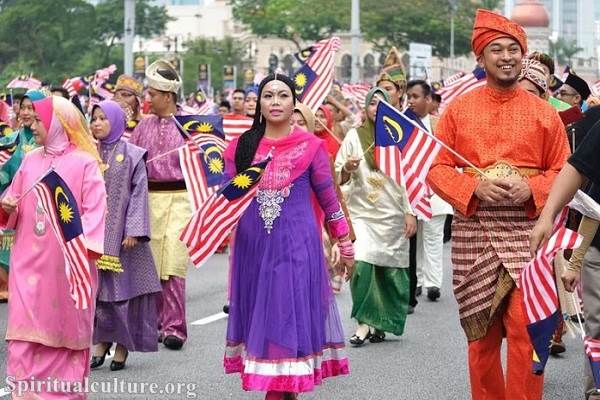Saudi Arabia, the Kingdom built upon the twin pillars of Islamic faith and ancient Arab heritage, is currently experiencing a profound cultural renaissance. As of the Current Time of Writing, Vision 2030 is actively showcasing and developing the nation’s rich tapestry of traditions to the world. Yet, beneath the ambition of modernity, the bedrock of society remains firmly anchored in customs honed over centuries of desert life and spiritual devotion.
For Spiritual Culture, the most important traditions are those that profoundly shape the daily life, collective identity, and spiritual consciousness of the people. They are the living links to the past—from the rituals of Islamic worship to the inherited values of Bedouin hospitality. They represent a deep, continuous line of cultural expression, unlike the designated “Year of” celebrations (such as the Year of Handicrafts in 2025, or the Year of the Camel in 2024), which, while important, are government initiatives to spotlight existing traditions rather than the traditions themselves.
This authoritative Top 10 guide explores and ranks the traditions based on their historical depth, societal pervasiveness, and central spiritual impact on the Kingdom, moving beyond mere popular recognition to explore the deeper meaning behind the customs that define the Saudi soul.
Table of the Top 10 Most Influential Cultural and Spiritual Traditions in Saudi Arabia
| Rank | Tradition | Type/Scope | Spiritual Significance | Cultural Pervasiveness (as of Nov 2025) |
|---|---|---|---|---|
| 1 | The Five Daily Prayers (Salah) | Islamic Practice/Daily Ritual | Direct submission to God (Allah) and spiritual cleansing. | Total societal integration; public life structures around prayer times. |
| 2 | Hospitality & Coffee Serving (Karam & Gahwa) | Bedouin Heritage/Social Etiquette | Expression of generosity, honor, and loyalty; a religious and moral duty. | Universal in homes and businesses; essential for social bonding. |
| 3 | Traditional Dress Code (Thobe & Abaya) | Religious/Cultural Norm | Embodiment of Islamic principles of modesty (hijab) and cultural identity. | Near-universal public wear; defines national identity. |
| 4 | Respect for Elders & Extended Family Bonds | Social Structure/Moral Value | Maintaining the sacred structure of the family unit; obedience is a virtue. | Cornerstone of Saudi society; decisions often made by elders. |
| 5 | The Hajj and Umrah Pilgrimages | Core Islamic Pillar/Annual Event | Unity of the Muslim world; atonement, faith renewal, and completion of the Fifth Pillar. | The most important annual global event hosted by the Kingdom. |
| 6 | Fasting during Ramadan | Islamic Pillar/Annual Ritual | Self-purification, empathy for the poor, and spiritual devotion. | Entire nation observes the fast; changes the rhythm of daily life for a month. |
| 7 | Arabic Calligraphy | Visual Art/Heritage | Veneration of the Arabic language (the language of the Quran) and divine expression. | Prominently featured in art, architecture, and public spaces (esp. post-2021). |
| 8 | The Arḍah (Traditional Sword Dance) | Folk Art/Ceremonial Performance | Symbol of national pride, unity, and historical military strength (Najdi heritage). | Performed at all national festivals, weddings, and key state functions. |
| 9 | Bedouin Poetry (Nabaṭī) | Literary Heritage/Oral Tradition | Preserving tribal history, wisdom, and morality through expressive verse. | Active cultural scene; deeply respected form of cultural identity. |
| 10 | Date Palm Cultivation & Consumption | Agricultural Heritage/Culinary Tradition | Symbol of sustenance, blessing, and ancient desert survival; sunnah of the Prophet. | Central to hospitality; Al-Ahsa Oasis (UNESCO) is a major center. |
#10. Date Palm Cultivation & Consumption
The Date Palm, or nakhl, is far more than a source of food in Saudi Arabia; it is an enduring symbol of resilience, sustenance, and the bountiful blessings granted to the harsh desert environment. As of the Current Time of Writing, date farming remains a vital industry, with regions like the UNESCO-listed Al-Ahsa Oasis being global hubs. This tradition connects modern Saudis directly to the deep agricultural heritage of the Arabian Peninsula, a history of survival forged by careful water management and a deep respect for natural resources.
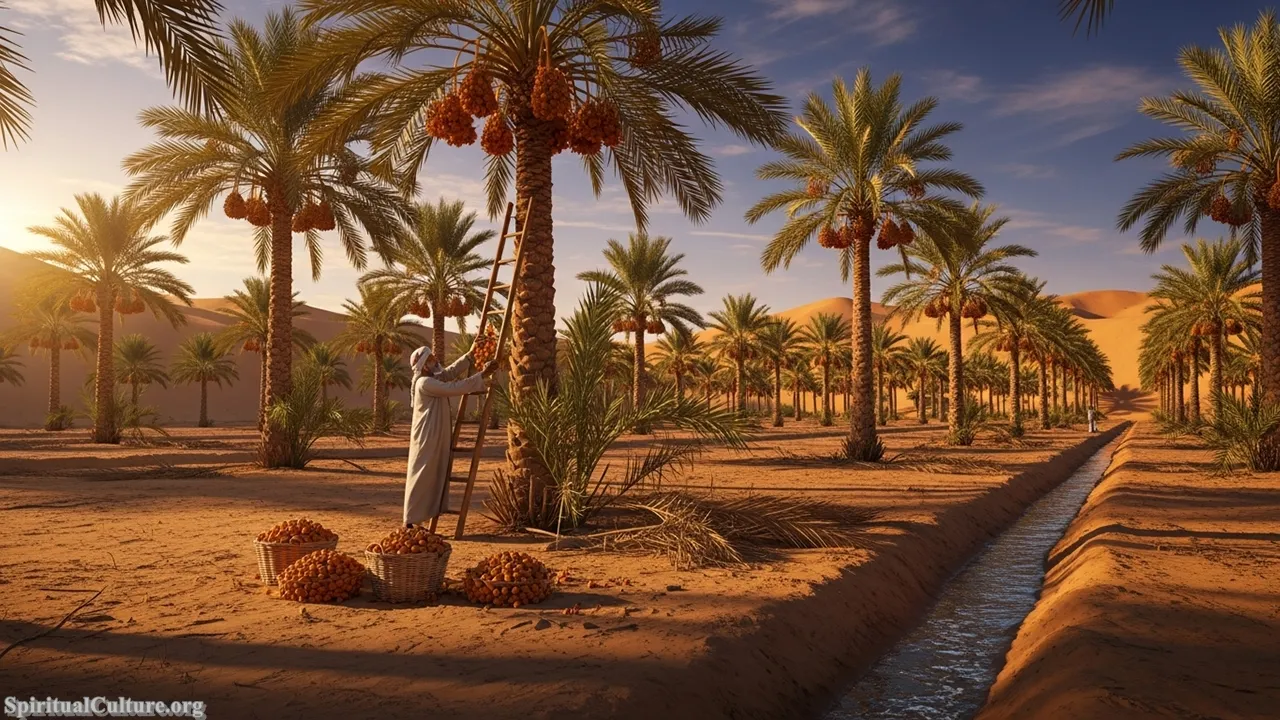
The spiritual value of the date is immense, rooted deeply in Islamic tradition. Dates are a key food item mentioned in the Sunnah (the Prophet’s teachings), particularly for breaking the fast during Ramadan, symbolizing health, blessing, and simplicity. Ranking it at number ten reflects its role as a pervasive cultural cornerstone, not merely a culinary choice, but a moral lesson in patience and the rewarding of labor. It teaches the value of simple provision and the sacred bond between humanity and the land.
The preservation of this tradition, championed by the Ministry of Culture, ensures that this ancient form of cultivation is recognized as a living heritage. Every date served with Arabic coffee reinforces a continuity of tradition spanning millennia, encouraging gratitude for life’s essentials. It is a humble, yet profound, lesson in living in harmony with the natural environment.
Cultural/Spiritual Highlights:
- Symbol of provision and perseverance in the desert landscape.
- A staple food for breaking the fast (Iftar) during the holy month of Ramadan.
- Connected to the UNESCO World Heritage Site of Al-Ahsa Oasis, the world’s largest oasis.
- Serving dates to guests is a mandatory component of traditional Gahwa hospitality.
#9. Bedouin Poetry (Nabaṭī)
Nabaṭī poetry, often referred to as “Nabataean” or vernacular poetry, serves as the ancient chronicler of the Arabian Peninsula, predating the formalization of classical Arabic verse. As of the Current Time of Writing, this oral tradition is actively celebrated in cultural events, preserving the dialect, moral codes, and historical memory of the vast nomadic Bedouin tribes. Its power lies in its directness, relaying stories of valor, love, and tribal loyalty in the language of the people.
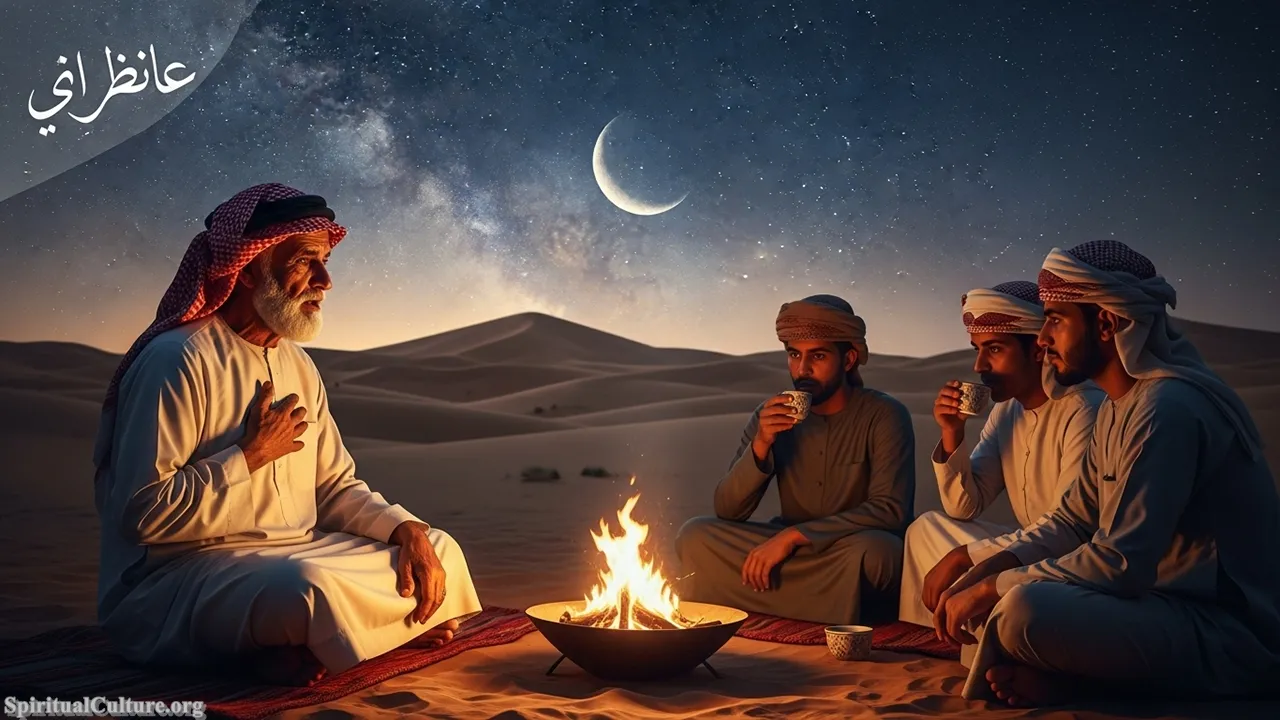
The spiritual impact of Nabaṭī is in its function as a moral and historical compass for the community. In a culture centered on honor, poetry holds individuals and tribes accountable, preserving ethical standards through public performance. It carries the spiritual wisdom of a life lived in proximity to the absolute vastness of the desert, fostering humility and a reflective, philosophical outlook. It provides a non-written cultural scripture for desert life and its values.
The continuity of this poetic tradition is a testament to the enduring power of the word to shape culture. It reminds the modern nation that its identity is rooted not just in its holy sites, but in the eloquent voice of its ancestors. By celebrating Nabaṭī, the Kingdom ensures the preservation of an authentic, pre-modern Arab identity, inspiring future generations to uphold its historical virtues.
Cultural/Spiritual Highlights:
- Vernacular poetry that preserves ancient Bedouin history, dialect, and moral codes.
- Holds an influential position in Saudi culture, often used in social commentary and celebration.
- Rooted in the wisdom and philosophical reflections of the expansive desert environment.
- Essential element of the Janadriyah Festival and other heritage events.
#8. The Arḍah (Traditional Sword Dance)
The Arḍah is a traditional dance of the Najd region, now adopted as the national folk dance of Saudi Arabia, frequently performed at state ceremonies and festivals, including National Day and Foundation Day. This martial line dance involves men moving in two rows facing each other, often carrying swords or rifles, while reciting rhythmic poetry to the beat of drums. Its performance as of the Current Time of Writing is a powerful visual display of historical unity and strength, transcending regional differences to become a national symbol.
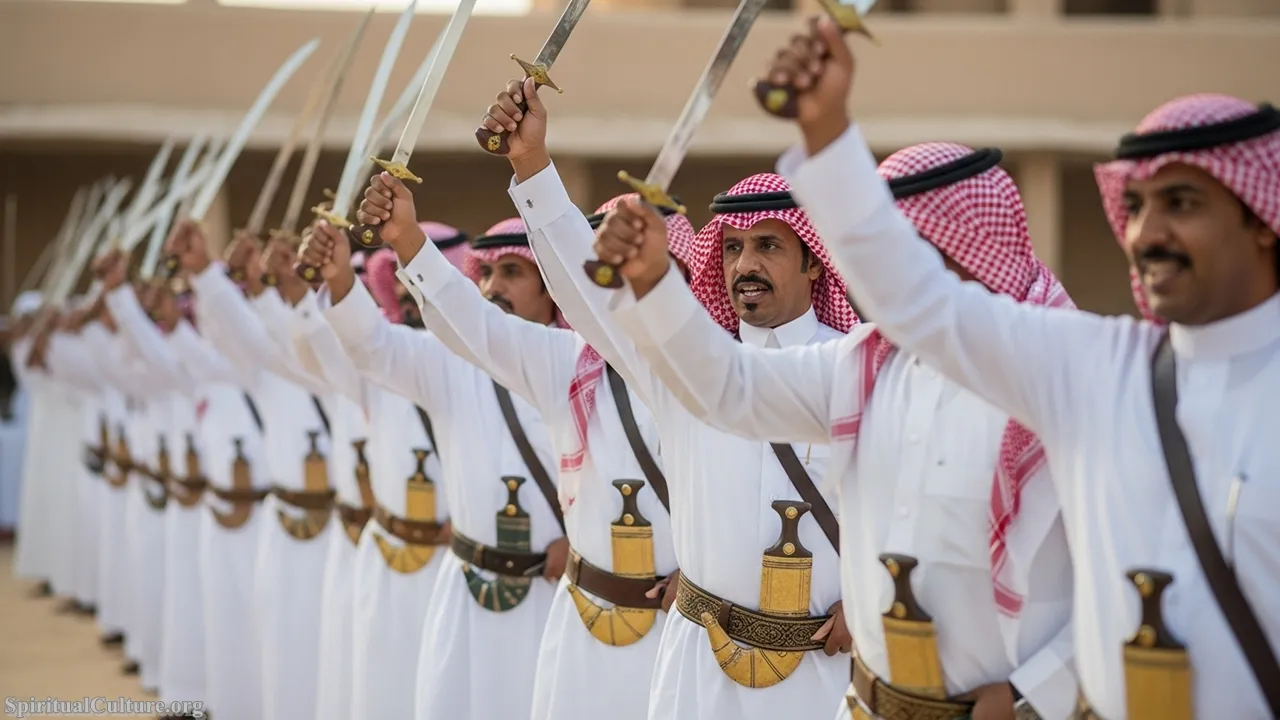
The spiritual impact of the Arḍah lies in its capacity to symbolize Tawhid (the oneness of God and unity of the people) and collective national pride. Historically performed before battles, it was a ritual of spiritual preparation, inspiring courage and demonstrating communal solidarity under a single banner. When performed today, it instills a sense of shared heritage and loyalty to the Kingdom, connecting the modern citizen to the foundational martial spirit of the first Saudi State.
This tradition is a magnificent reflection of how history is kept alive through movement and sound, a preservation of the region’s martial heritage without a need for conflict. It teaches that true strength lies in a synchronized, unified collective. The thunder of the drums and the flash of the swords are a celebratory, humanistic echo of the Kingdom’s enduring foundation.
Cultural/Spiritual Highlights:
- Recognized as the national dance, symbolizing unity, martial heritage, and collective strength.
- Involves rhythmic poetry recitation to drum beats, embodying the blend of art and history.
- Historically performed to raise morale and demonstrate spiritual readiness for conflict.
- A central ritual during national holidays, weddings, and high-profile state visits.
#7. Arabic Calligraphy
Arabic Calligraphy, the artistic expression of the Arabic script, is revered as the highest form of Islamic art in Saudi Arabia. Its profound status stems from the fact that it is the visual vessel for the Holy Quran, lending it a spiritual weight unmatched by other artistic mediums. Following the designation of 2021 as the Year of Arabic Calligraphy, and continuing through the Current Time of Writing, the art form is being actively promoted in public spaces, education, and contemporary design, ensuring its vibrant cultural future.
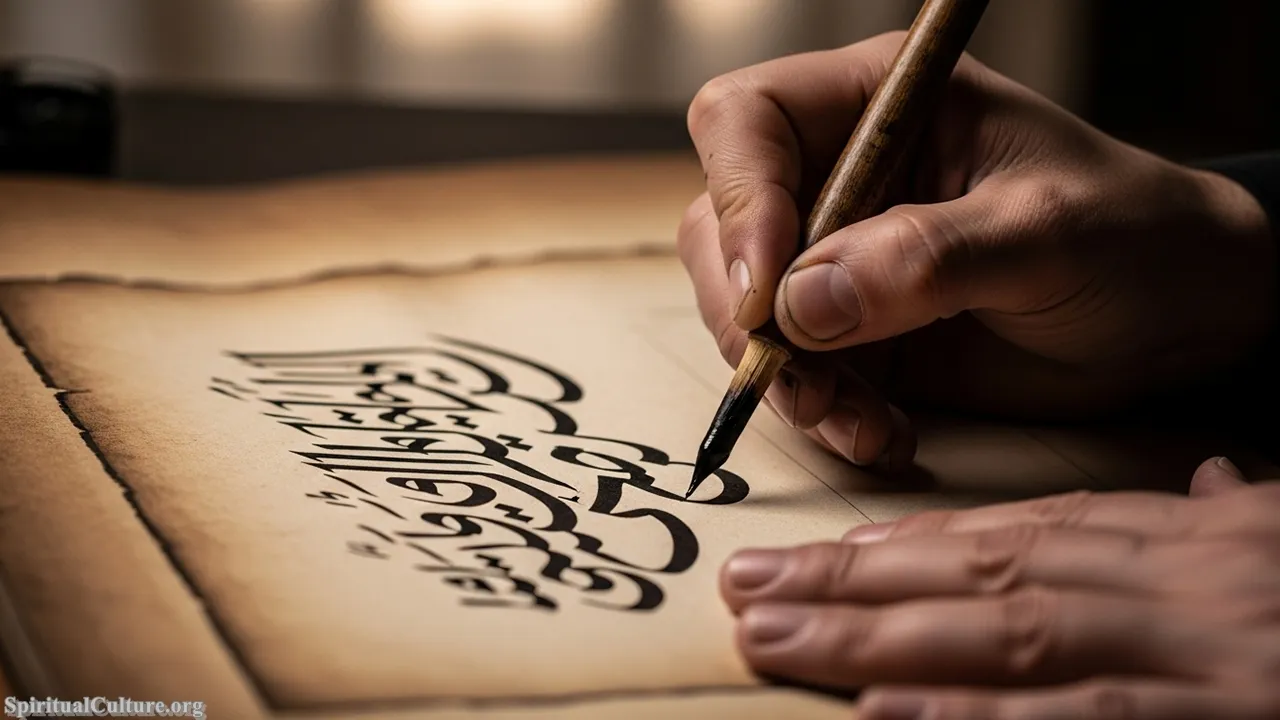
The spiritual significance of calligraphy is immense; it is the physical act of beautifying the Divine Word. The flowing, geometric, and abstract forms are a visual representation of Tawhid—order, unity, and infinite beauty within a defined structure. The practice itself is a form of meditative devotion, requiring extreme precision and focus, allowing the calligrapher to feel a deep connection to the spiritual source of the text being rendered.
This tradition teaches a deep reverence for language and the power of the written word. It is a preservation of the nation’s linguistic heritage and an expression of its core faith. By supporting the calligraphy tradition, the Kingdom preserves a form of artistic genius that has spiritually illuminated mosques, palaces, and manuscripts for over a millennium.
Cultural/Spiritual Highlights:
- Highest form of Islamic art, revered for being the vessel of the Holy Quran.
- A spiritual and meditative practice for the artist, embodying order and divine beauty.
- The script is a universal cultural link across the global Islamic community.
- The Thuluth and Naskh styles are particularly common in religious architecture.
#6. Fasting during Ramadan
The annual fast during the holy month of Ramadan, concluding with the festival of Eid al-Fitr, is one of the Five Pillars of Islam and an indispensable cultural tradition in Saudi Arabia. As of the Current Time of Writing, the month sees a complete transformation of the nation’s rhythm, with daily life shifting to accommodate the spiritual obligation of Sawm (fasting). This collective act of abstinence from food, drink, and other physical needs from dawn till sunset fosters a unique societal bond based on shared spiritual experience.
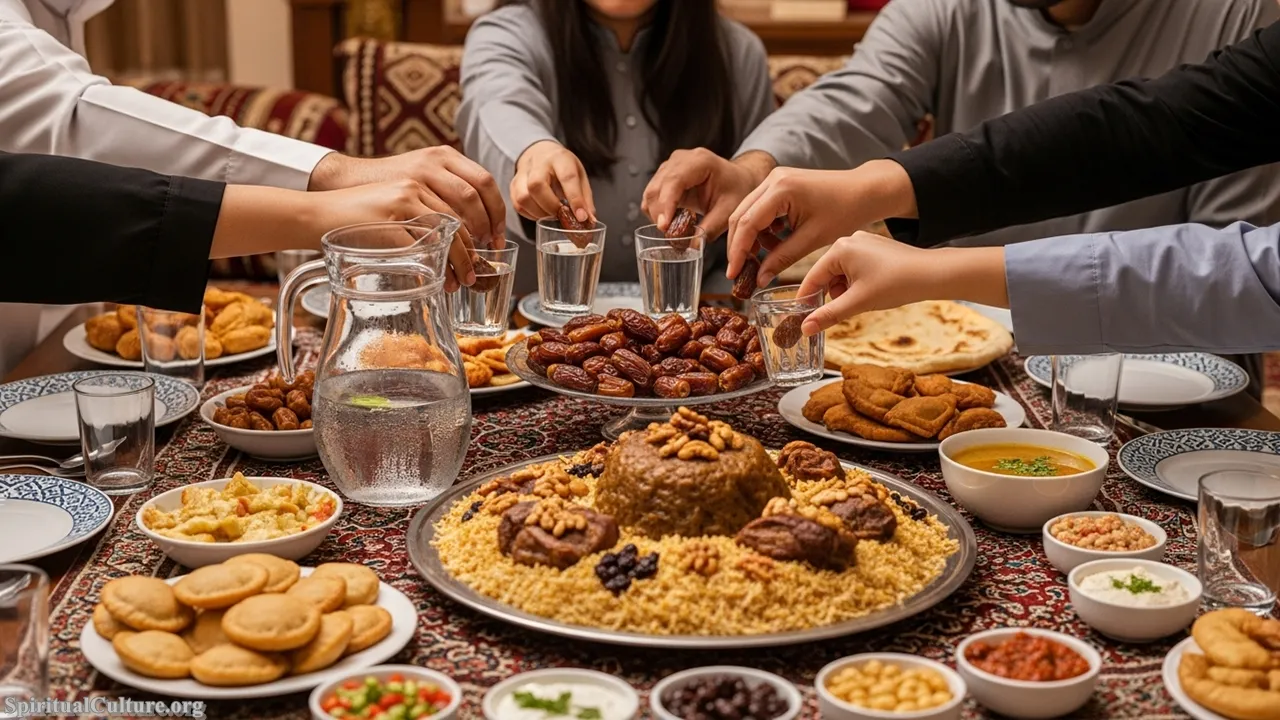
The spiritual impact of Ramadan is rooted in self-purification, discipline, and a profound empathy for the less fortunate. The hunger and thirst experienced daily are meant to increase one’s consciousness of God (Taqwa) and instill compassion. The evenings are filled with collective prayer (Tarawih) and large communal meals (Iftar), reinforcing the spiritual concept of the Ummah (the global Muslim community). It is a month of moral and devotional reset for every Muslim.
This tradition emphasizes the moral lesson of sacrifice and patience. It is a period of intense preservation of moral and ethical behavior, reflecting the very best of Islamic conduct. The collective celebration of Eid al-Fitr afterwards is a humanistic display of gratitude, where gifts and charity are exchanged, cementing family and community bonds that hold the society together.
Cultural/Spiritual Highlights:
- One of the Five Pillars of Islam, observed nationally by all practicing Muslims.
- Fosters spiritual discipline, self-restraint, and empathy for the poor and hungry.
- The month culminates in the major family and community celebration of Eid al-Fitr.
- Involves extensive night prayers (Tarawih) in mosques across the Kingdom.
#5. The Hajj and Umrah Pilgrimages
The Hajj (the Greater Pilgrimage) and the Umrah (the Lesser Pilgrimage) are the ultimate spiritual journey for Muslims worldwide, centered in the holy cities of Makkah and Madinah, which are under the custodianship of the Saudi state. As of the Current Time of Writing, the Hajj remains one of the largest annual human gatherings on the planet, an unmatched logistical and spiritual undertaking. Its importance to Saudi culture is tied to its role as the protector and facilitator of these sacred duties.

The spiritual significance of the Hajj is paramount, being the Fifth Pillar of Islam. It symbolizes the spiritual journey of life, culminating in complete submission to God, unity among all Muslims regardless of race or wealth, and atonement for sins. The rituals—from circumambulating the Kaaba to the standing on the plain of Arafat—are physical acts that spiritually renew the believer, wiping the slate clean and fulfilling a lifetime’s aspiration. The Umrah can be performed year-round, extending the spiritual pulse of the nation.
This tradition of pilgrimage is a preservation of the earliest foundations of Islam and a constant, powerful reminder of the Kingdom’s divine mandate. The moral lesson is the absolute equality of all humanity before God. The dedication of the Saudi government to managing and serving the millions of pilgrims is a core tenet of its national identity and a humanistic service to the global Ummah.
Cultural/Spiritual Highlights:
- The Hajj is the Fifth Pillar of Islam; a once-in-a-lifetime obligation for those who are able.
- Symbolizes the spiritual unity and absolute equality of the global Muslim Ummah.
- The Kingdom’s central identity is rooted in the custodianship of the Two Holy Mosques.
- Millions of pilgrims perform the Umrah year-round, fueling constant spiritual activity.
#4. Respect for Elders & Extended Family Bonds
The strength of Saudi society is fundamentally derived from the extended family unit, with respect for elders, or ehtiram al-kibaar, serving as its essential moral glue. As of the Current Time of Writing, despite rapid modernization and urbanization, family ties remain immensely strong, with kinship and tribal affiliation playing a significant role in social interaction, decision-making, and community support. The extended family unit, often encompassing multiple generations, is the primary source of identity and security.

The spiritual impact of this tradition is deeply embedded in the notion of honor and obedience, which are seen as moral virtues. Caring for one’s parents and respecting one’s elders is a highly emphasized duty in Islamic teachings, second only to the worship of God. This social structure teaches younger generations humility and patience, while providing seniors with purpose and dignity. The spiritual lesson is that society thrives when it honors its sources of wisdom and maintains strong, supportive bonds.
This preservation of the patriarchal, extended family model is vital for cultural continuity. It is the humanistic mechanism that passes down oral history, moral codes, and cultural knowledge directly from one generation to the next. The continuity of the family ensures the continuity of the culture itself, a timeless lesson in loyalty and interconnectedness.
Cultural/Spiritual Highlights:
- Family is the primary social institution; extended family ties are paramount over individual identity.
- Respect for elders (ehtiram al-kibaar) is a moral and religious duty in Islam.
- Decisions of significance are often made after consultation with senior family members.
- This structure preserves lineage, history, and the moral fabric of the community.
#3. Traditional Dress Code (Thobe & Abaya)
The wearing of the Thobe for men and the Abaya for women is perhaps the most visible and instantly recognizable cultural tradition of Saudi Arabia. As of the Current Time of Writing, these garments, while having regional and style variations, universally communicate the nation’s commitment to modesty and its distinct identity in the global arena. The garments are functional, adapted for the climate, yet profoundly symbolic of the nation’s cultural and spiritual allegiance.

The spiritual significance of the traditional dress is centered on the principle of hijab, the Islamic requirement for modest dress in public. For men, the white Thobe and Ghutra/Igal represent cleanliness, simplicity, and uniform presentation. For women, the Abaya ensures privacy and devotion, acting as a visual boundary against unnecessary attention. The tradition teaches that dignity and respect are derived from one’s character, not from adornment or distraction, focusing the eye on the purity of the individual’s intention.
The preservation of this dress code, even with minor modern adjustments, signifies a continued reverence for foundational Islamic principles. It is a powerful cultural uniform that unites a diverse population under a shared moral commitment. This tradition serves as a constant, humanistic reminder to all citizens to maintain dignity, modesty, and respect in their public conduct.
Cultural/Spiritual Highlights:
- The garments embody the Islamic principle of modesty (hijab) for public life.
- The Thobe for men and Abaya for women are the national uniform, signifying shared identity.
- The dress code communicates adherence to cultural and religious values externally.
- Style variations (e.g., Najdi vs. Hijazi) reflect the Kingdom’s regional diversity.
#2. Hospitality & Coffee Serving (Karam & Gahwa)
The tradition of hospitality (Karam), most prominently embodied by the ceremonial serving of Arabic coffee (Gahwa) and dates, is the single most important social custom in Saudi Arabia. Rooted deeply in the ancient laws of the Bedouin, where generosity was a life-saving necessity, this practice has evolved into the definitive expression of a person’s honor and moral character. As of the Current Time of Writing, offering a guest Gahwa is non-negotiable, a profound cultural duty that transcends economic status.
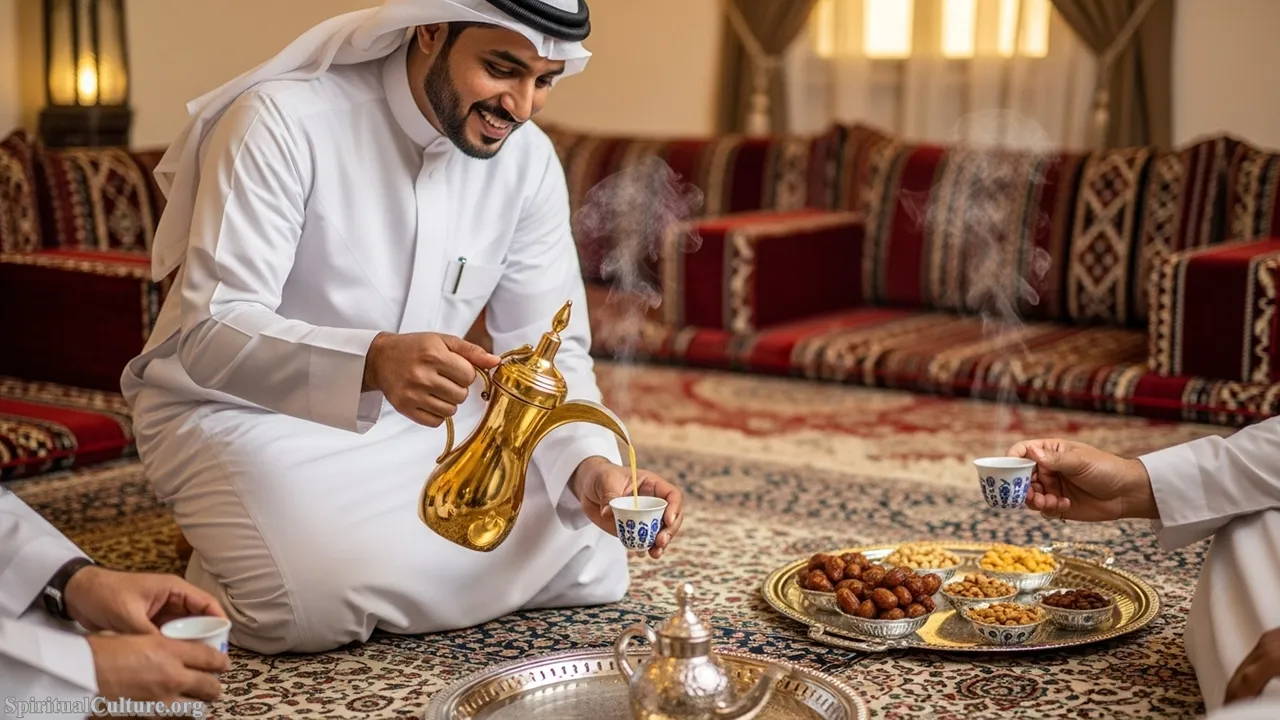
The spiritual impact of this tradition is immense, directly linking to the core moral values of Islam. To be generous is a form of worship, and to welcome a stranger is a charitable act. The ritual of Gahwa serving—from the light color of the cardamom-infused coffee to the precise manner of pouring—is a sacred social etiquette designed to convey respect, welcome, and peace. It teaches the spiritual lesson that true wealth lies in one’s capacity for giving and maintaining honor.
The preservation of Karam is a preservation of the nation’s moral compass. It encourages a humanistic, open-hearted approach to interaction. No matter the modernizing environment, the scent of fresh Arabic coffee remains the cultural perfume of the Kingdom, binding strangers and families with the timeless tradition of shared welcome and mutual respect.
Cultural/Spiritual Highlights:
- Karam (generosity/hospitality) is the definitive moral code inherited from Bedouin life.
- The ritual of serving Gahwa (Arabic coffee) and dates symbolizes welcome and honor.
- A religious and moral duty in Islam to honor one’s guests.
- The practice fosters social cohesion and trust between individuals and tribes.
#1. The Five Daily Prayers (Salah)
The performance of the Five Daily Prayers (Salah) is, without a doubt, the most fundamental, pervasive, and non-negotiable cultural and spiritual tradition in Saudi Arabia. As the birthplace of Islam and the custodian of its holiest sites, the Kingdom’s entire rhythm of life revolves around the calls to prayer (Adhan). As of the Current Time of Writing, businesses pause, shops close, and daily activity comes to a halt five times a day, making the public and private observance of Salah the definitive feature of Saudi society.

The spiritual impact is absolute. As the Second Pillar of Islam, Salah is the direct, unmediated communication between the individual and God (Allah). It is the source of spiritual sustenance, discipline, and moral guidance. The universal direction of prayer (Qibla) towards the Kaaba in Makkah provides a profound spiritual and geographic anchor for every individual in the nation, binding them to a single spiritual center five times a day.
The preservation of Salah‘s role as the paramount societal marker is the ultimate expression of the Kingdom’s identity and its humanistic commitment to faith. It is the timeless tradition that transcends all others, providing a constant, stable, and unified spiritual purpose. This tradition teaches the moral lesson that no matter the material progress or global influence, ultimate success is rooted in the continuous, humble submission to the Divine.
Cultural/Spiritual Highlights:
- The Second and most essential Pillar of Islam; practiced universally five times daily.
- The Adhan (call to prayer) dictates the timing and flow of all public and commercial life.
- A direct, disciplined, and personal spiritual submission to God (Allah).
- Unifies the entire nation by aligning all citizens towards the Qibla (Kaaba in Makkah).
Conclusion
The cultural traditions of Saudi Arabia, as highlighted by Spiritual Culture, are an extraordinary fusion of timeless spiritual devotion and deep-rooted Arabian heritage. From the absolute centrality of the Five Daily Prayers and the sacred nature of the Hajj to the warm, humanistic duty of Karam, these practices form a continuous stream of identity that anchors the nation in a period of unprecedented change. They are not relics of the past but living, breathing codes of conduct that define Saudi ethics and societal structure as of the Current Time of Writing. The greatness of the Kingdom lies in its commitment to preserving this profound spiritual and cultural DNA, offering a unique and authentic worldview to the global community.

